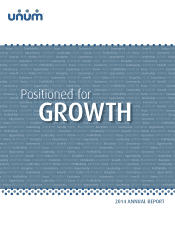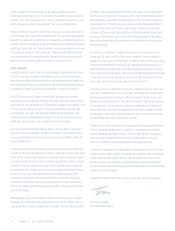Unum 2014 Annual Report Download - page 5
Download and view the complete annual report
Please find page 5 of the 2014 Unum annual report below. You can navigate through the pages in the report by either clicking on the pages listed below, or by using the keyword search tool below to find specific information within the annual report.
UNUM • 2014 ANNUAL REPORT 3
This success comes despite the impact today’s low interest rate
environment continues to have on our investment results, especially
on our group long-term disability and long-term care lines of business.
During the year we strengthened our long-term care reserves by
nearly $700 million to better reflect a continuation of this low interest
rate environment. I’m confident that we are doing all the right things
to manage this business (a product that we no longer sell but continue
to service). We are also taking the appropriate pricing actions in those
product lines that are more sensitive to interest rates, such as group
long term disability. While we never like to raise prices, it is the most
prudent thing to do in this environment.
During 2014, with strong capital generation from our core operations, we
continued our practice of returning excess capital to our shareholders.
We repurchased another $300 million of our stock, bringing our total
since 2007 to $2.8 billion, or nearly 32 percent of our outstanding
shares. Additionally, we increased our dividend nearly 14 percent,
marking the sixth consecutive year of double-digit dividend increases.
Our capital position
remains strong, again
exceeding most of our
targets in 2014, giving
us the flexibility to both
support the needs of
our business while
also returning capital
to shareholders.
Although our
longer-term total
shareholder return
continues to outperform
our industry and the
broader market, I am disappointed that our stock’s performance in
2014 was below that of our peers. We believe the uncertainty around
interest rates and our long-term care business impacted investors’ views
of our company more so than the strong financial and operating results
we achieved throughout the year. I’m confident, though, that these
factors remain important to investors and will ultimately be recognized
in the market, and that we are on the right path to continue to create
long-term value for our shareholders.
A GROWING NEED FOR WHAT WE DO
At Unum, we are well aware of the important role we play in helping to
protect the financial futures of individuals and their families, as well as
in helping employers better manage their businesses. Last year, we paid
more than $6.7 billion in benets and, in our group disability business
alone, enabled more than 230,000 individuals to return to work and
a productive lifestyle, while giving millions of others the peace of
mind that comes with protecting themselves and their loved ones.
In addition, more than 178,000 companies large and small have
entrusted us to help their employees protect their futures.
Challenging economic conditions in recent years combined with
shifting employee benefits trends have created an even greater
need for our products and services. The value of what we do becomes
especially clear when you consider:
• With nearly 70 percent of consumers in the U.S. and U.K. living
paycheck-to-paycheck, most consumers lack the resources to
support themselves should a significant illness or injury occur.
• Yet life-changing events occur more frequently than many people
expect. In fact, one out of four of today’s 20-year-olds will be out
of work for at least six months due to a disability over the course
of their working years, with little to fall back on.
• Unfortunately, most consumers are under-insured against these
very real risks. For example, 66 percent of working Americans lack
basic disability coverage, and the situation is even bleaker in the
U.K., where 92 percent lack basic disability coverage. This lack of
coverage can have devastating financial consequences on the
goals and aspirations of individuals and their families.
As we know all too well, governments lack the financial resources to
expand their welfare programs to provide adequate coverage for
those facing these issues. Often the best, and only, opportunity for
workers to obtain basic financial protection is through the workplace.
In fact, nearly 90 percent of all disability insurance is purchased at the
workplace, while roughly 80 percent of all life insurance coverage is
acquired there – facts that have changed very little in spite of health-
care and other market reforms.
As a leading provider of workplace benefits, we see a tremendous
opportunity to grow the market and believe we are in a strong position
to d o s o – in par t by bu ildi ng from o ur 165 years of indu st ry ex pertise, and
the strong customer relationships and reputation we have established
over the years, but it goes beyond that.
Last year in the U.S., in an attempt to reduce the uninsured population,
we proposed legislation that would make it easier for employers to
offer disability insurance on an “opt-out” basis, or, in other words, to
provide coverage at the time of employment, with the employee able
to decline it later if they so choose. This approach has proven highly
successful in increasing the participation in 401(k) or retirement saving
plans, and we believe this proposed legislation can help to fill a critical
protection gap in this country. We remain hopeful that this legislation
will gain the necessary support it needs in Congress.
We are also continuing to invest heavily in our consumer research
capabilities to better understand and engage consumers. There’s a
reason so few consumers elect not to purchase this coverage when it’s
offered in the workplace. We’ve already taken a number of critical
10
CONSOLIDATED OPERATING
RETURN ON EQUITY
11.9%
12.2%
12.3%
11.4%
11.4%
11 12 13 14


















